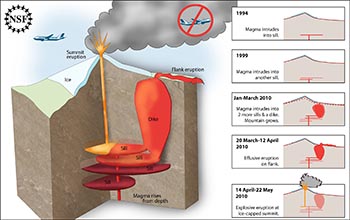Months of geologic unrest signaled reawakening of Icelandic volcano
Months of volcanic restlessness preceded the eruptions this spring of Icelandic volcano Eyjafjallajökull, providing insight into what roused it from its centuries of slumber.
An international team of researchers analyzed geophysical changes in the long-dormant volcano leading up to its eruptions in March and April 2010. In a study published in the Nov. 18 issue of the journal Nature, the scientists suggest that magma flowing beneath the volcano may have triggered its reawakening.
“Several months of unrest preceded the eruptions, with magma moving around downstairs in the plumbing and making noise in the form of earthquakes,” says study co-author Kurt Feigl, a professor of geoscience at the University of Wisconsin–Madison. “By monitoring volcanoes, we can understand the processes that drive them to erupt.”
Artist’s conception illustrating the three-dimensional geometry (left) and timing of events (right column) at Eyjafjallajökull volcano in Iceland. The complicated plumbing inside the volcano consists of inter-connected conduits, sills, and dikes that allow magma to rise from deep within the Earth. The first three panels in the time series show distinct intrusive episodes of magma that caused measurable deformation and seismic events in 1994, 1999, and in the first several months of 2010. No eruptive activity occurred during this period of unrest. The fourth panel illustrates the first eruption, between 20 March and 12 April 2010, when basaltic magma (orange) erupted onto the Earth’s surface on the flank of the mountain. The fifth panel shows the second eruption, between 14 April and 22 May, when a different type of magma (trachyandesite, shown in red), erupted explosively under the ice-capped summit. The interaction of magma and ice initially increased the explosive activity, generating a plume of particles that rose as high as the 30,000-foot flight level and disrupted air traffic across Europe for weeks. Credit: Zina Deretsky, National Science Foundation
Lead study author Freysteinn Sigmundsson, at the University of Iceland, along with Feigl and collaborators from Iceland, Sweden, and the Netherlands watched the deformation of the volcano’s edifice using a combination of satellite imaging and GPS surveying. They found that Eyjafjallajökull swelled for 11 weeks before it began to erupt in March 2010 from one flank, a culmination of 18 years of intermittent unrest.
“If you watch a volcano for decades, you can tell when it’s getting restless,” Feigl says.
Eyjafjallajökull had shown similar signs of stirring in 1994 and 1999. In late summer 2009, a subtle shift at a GPS station on the volcano’s flank prompted Sigmundsson and his colleagues to begin monitoring the mountain more closely. In early January 2010, the rate of deformation and the number of earthquakes began to increase. As the deformation and seismic unrest continued, the researchers installed more GPS stations near the mountain. Just a few weeks later, the instruments detected more rapid inflation, indicating that magma was moving upwards through the “plumbing” inside the volcano.
By the time the volcano began to erupt on March 20, the volcano’s flanks had expanded by more than six inches as magma intruded into a series of underground structures called a dike and sills.
Surprisingly, the rapid deformation stopped as soon as the eruption began. Although many volcanoes deflate as magma flows out of shallow chambers during an eruption, Eyjafjallajökull maintained basically the same inflated shape through mid-April, when the first eruption ended.
After a two-day pause, the volcano began to erupt again on Apr. 22. This time, the lava broke out through a new vent under the ice-capped summit of the mountain. This second eruption exploded as gas escaped from bubbles in the magma, fragmenting the rock into tiny particles called “tephra.” Aggravating the explosion, steam blew out of the vent as hot lava melted a pathway through the ice in a matter of days. The resulting plume rose high into the atmosphere, disrupting air traffic over Europe for weeks and stranding millions of travelers.
Why did Eyjafjallajökull erupt when it did? The geologic processes that trigger an actual eruption are not yet well understood, says Feigl. “We’re still trying to figure out what wakes up a volcano.”
To begin to answer this question, the scientists suggest that magmatic intrusions deep within the volcano started the processes leading to the eruption. “It was the meeting of two different magma types, one residing under the summit area, and another in the evolving intrusion, that triggered the explosive eruption, ” says Sigmundsson.
The researchers are also currently studying the structures inside the volcano, such as magma chambers and intrusive conduits, by extracting information from the sensors installed around Eyjafjallajökull.
“The explosiveness of the eruption depends on the type of magma, and the type of magma depends on the depth of its source,” Feigl says. “We’re a long way from being able to predict every eruption, but if we can visualize the plumbing inside the volcano, then we’ll improve our understanding of the processes driving volcanic activity.”
Satellite radar images were obtained from TerraSAR-X, a satellite operated by the German Space Agency (DLR). Funding was provided by a RAPID grant from the U.S. National Science Foundation as well as by the Icelandic Research Fund, the University of Iceland, and the Icelandic government.
The paper, including a complete list of authors, is available from Nature. Additional related content is available here.





